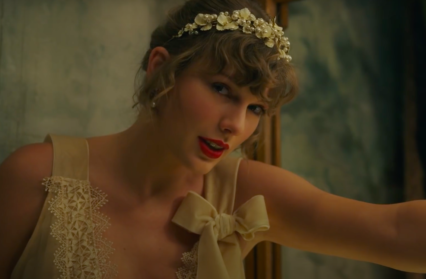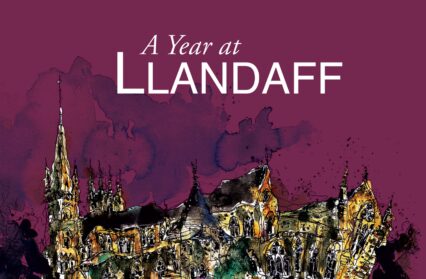Taylor Swift is back with her second surprise album of the year. Caragh Medlicott explains why evermore is the natural out-breath to the inhaled introspection of Swift’s earlier release, folklore.

“To put it plainly, we just couldn’t stop creating” – this, an explanation for the second dressed-down Taylor Swift album of the year. Not even six months have passed since the surprise release of folklore, a lockdown album which saw Swift ditch sonic technicolour and sweeps up plaid, indie lullabies. Now, she’s back with evermore – folklore’s “sister record” – and it seems the wooded escapade is far from over. With a swollen, fifteen-strong tracklist, it’s enough to make you embarrassed that you ever felt proud of your banana bread.
Certain things have changed since folklore dropped in July. Back then, Swift’s collaborations with The National’s Arron Dessner and Bon Iver’s Justin Vernon marked a watershed moment. Now – following press interviews and a Disney+ special – they’re practically part of the furniture. New names appear here, too, but not surprising ones; there’s a song with two members of the Haim trio, an official track with The National, and a vocal appearance from Marcus Mumford. While folklore appeared to ditch Swift’s preferred album release extravaganza, the past few months have proven that she’s never lost her penchant for hidden easter egg clues. From sneaky song references to symbolic Instagram colour schemes, evermore has been decoded by an army of delighted Swifties (from the inside, it’s innocent fun – from the outside, it’s all a little more bizarre).
In a groundhog day-style repeat, fans were notified of evermore’s existence mere hours before its release. As you’d expect from its familial relation to folklore – and similar cottagecore aesthetic – evermore continues with the indie vibe, though it develops its quieter acoustics into something resembling alt-pop. The fictional tales have expanded here, too. On folklore’s “mirror ball”, Swift sang of a locked-down world: “And they called off the circus / Burned the disco down” – but on evermore, those gaping absences have been filled with new, and more fantastical fictions. Songs about Harry Styles and Jake Gyllenhaal feel like a lifetime ago.
If folklore was the result of inhaled introspection, evermore is its natural out-breath. From a countrified murder mystery on “nobody, no crime” to star-crossed con artists on “cowboy like me”, Swift is clearly having fun spinning tales from her golden yarn. There’s no obvious overarching theme – this record is an indulgence of fantasy and experimentation – but tracks are loosely threaded together by Dessner’s musical arrangements and Swift’s pensive brand of storytelling. The scope for a broader anthology of fictions has clearly played a part in Swift’s renewed inspiration; after all, moving away from her biographical back-catalogue is what first set the folklore campfire burning. Trying on a wide set of personas has also opened up Swift’s emotional acuity. She was once queen of the breakup anthem, patroller of the moral high ground from which sinners could be condemned. Now, like folklore before it, evermore offers more sympathetic consideration of infidelity and the many complexities of loving and being loved.
On “ivy”, Swift sings from the perspective of a married protagonist falling for someone else: “My pain fits in the palm of your freezing hand / Taking mine, but it’s been promised to another” – it’s coupled with subtle guitar twangs, a melodic push-and-pull that melts into a track steeped in longing. On an uncharacteristically jingle-free Christmas number – “tis the damn season” – Swift imagines an aspiring actress returning to her hometown to reunite with an old flame, if just for a night: “I’m stayin’ at my parent’s house / And the road not taken looks real good now”. These stories are far-removed from Swift’s real love life (it was recently revealed that mysterious folklore co-writer William Bowery is, in fact, Swift’s British boyfriend Joe Alwyn), yet this does nothing to limit the depth of her imagined perspectives. Describing a divorce on “happiness”, the chorus follows a bittersweet refrain: “There’ll be happy after you / but there was happiness because of you.”
On a full listen, evermore clocks in at 60 minutes (and that’s not accounting for the two bonus tracks). There’s a lot of it. Much like folklore, there are no bad songs, yet greater curation could have shaped a swimmingly vast album into something more acute; the standout tracks tower above evermore’s more tepid numbers. On “coney island” – featuring The National – the band’s trademark sonic melancholy borders on drab. It’s hard to believe that its lyrics, “The fast times, the bright lights, the merry go / Sorry for not making you my centrefold,” are meant to hold any serious romantic sentiment. Swift has talked extensively about the liberation she’s uncovered in creating folklore – and now evermore – as she’s thrown off the restraints demanded by pop success (she’s even dropped numerous f-bombs for the first time in her career). Still, this removal is not as distinct as it might seem; upbeat numbers such as “long story short” wouldn’t feel so out of place on Swift’s pop albums of the past. If anything, evermore represents Swift’s instincts at their most organic – untempered by the need for earworm choruses.
Fictions might run throughout evermore, but there are personal touches here, too. On “marjorie”, Swift remembers her grandmother – an opera singer whose singing is sampled on the outro. This personal history hits the hardest nestled amongst more speculative imaginings. There’s also a personal context to evermore as a follow-up album; Swift’s fight to reclaim her masters have reached an unfortunate end. She has since announced plans to re-record her first six albums, and evermore will surely keep fans hooked into her latest music until they are completed. This isn’t to say that evermore has been rushed out the door for economic purposes. Swift and Dessner’s collaboration has proven to be an intuitive one, it sits naturally adjacent to her longtime work with producer Jack Antonoff (who seems to have been substituted out for most of this album).
At its best, evermore soars. Perhaps it’s Swift’s country background but her lyrics are at their brightest when rooted in a coherent narrative. Tethered to a story, Swift’s words blossom with honesty; imagining the aftermath of a rejected wedding proposal on “champagne problems”, Swift sings: “She would’ve made such a lovely bride / What a shame she’s fucked in the head.” By contrast, evermore’s opening track – “willow” – features far-flung metaphors that jump from the romantic (“Life was a willow and it bent right to your wind”) to the witty, yet unbefitting (“But I come back stronger than a ‘90s trend”). Sound-wise, Dessner has an even larger production influence here than on folklore. The result is feathery chamber pop, layered textures and occasional tips into effervescence. With Swift’s poised and oft-cutting vocal work, songs range from melodic dirge to goosebump-raising heights.
evermore by Taylor Swift is out now.
Caragh Medlicott is a Wales Arts Review senior editor.
_______________________________________________________________________
Recommended for you:


 Enjoyed this article? Support our writers directly by buying them a coffee and clicking this link.
Enjoyed this article? Support our writers directly by buying them a coffee and clicking this link.







